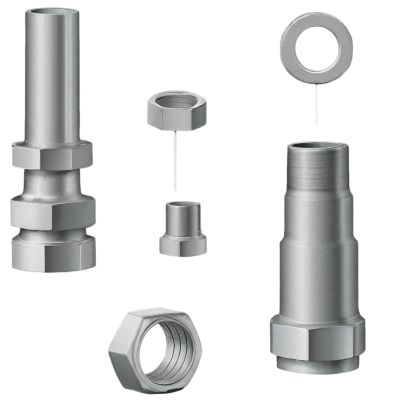Keeping your home cool and comfortable during the summer relies heavily on your air conditioning system functioning properly. One crucial but often overlooked component is the AC compression fitting.
These fittings ensure secure connections between the copper refrigerant lines within your AC system. Regular maintenance of these fittings is essential to prevent leaks, ensure optimal performance, and extend the lifespan of your AC unit.
This guide will equip you with the knowledge to perform basic maintenance on your AC compression fittings and keep your cool all summer long.
Understanding AC Compression Fittings
There are two main types of AC compression fittings:
1. Nut and ferrule: This is the most common type. It consists of a compression nut, a ferrule (ring), and the copper tube itself. Tightening the nut compresses the ferrule onto the tube, creating a secure seal.
2. Bite type: This fitting uses a mechanism with teeth that “bites” into the copper tube when tightened, forming a tight connection.
Signs of Failing AC Compression Fittings
Early detection of failing compression fittings can save you from bigger problems down the road. Here’s what to watch out for:
➡️ Visible leaks: Keep an eye out for water stains around the fittings or the AC unit itself. Refrigerant leaks may also be present, indicated by a hissing sound or oily residue near the fitting.
➡️ Reduced cooling efficiency: If your AC system struggles to maintain the desired temperature, it could be a sign of a refrigerant leak due to a failing fitting.
➡️ Corrosion: Rust or discoloration on the fitting components suggests wear and tear, potentially leading to leaks in the future.
➡️ Loose fittings: Fittings that can be easily tightened by hand are no longer secure and require immediate attention.
Essential Maintenance Procedures for AC Compression Fittings
Here are some simple maintenance practices you can perform to keep your AC compression fittings in top shape:
➡️ Inspection: Regularly inspect your AC unit and surrounding areas for signs of leaks, corrosion, or loose fittings.
➡️ Tightening: Over time, fittings can loosen due to vibration. Use an adjustable wrench (of the appropriate size) to ensure the fittings are secure, but avoid overtightening, which can damage the components.
➡️ Cleaning: Dirt and debris buildup around the fittings can increase the risk of leaks. Use a rag or wipe to clean the fittings and surrounding area.
➡️ Replacement: If you find a worn, damaged, or leaking fitting, replace it promptly to prevent further issues.
Tools and Materials Needed for AC Compression Fittings Maintenance
For this routine maintenance, you’ll need a few basic tools:
➡️ Adjustable wrench (sized for your AC unit’s fittings)
➡️ Leak detector (optional: electronic or soap solution)
➡️ Rags or wipes
➡️ Replacement fittings (if necessary)
Safety Precautions When Maintaining AC Compression Fittings
Before starting any maintenance work:
➡️ Turn off the AC system and electrical power at the breaker box to avoid electrical shock.
➡️ Wear eye protection and gloves to protect yourself from refrigerant contact or injuries from tools.
➡️ Be aware of the potential hazards of refrigerant leaks. Refrigerant can be harmful to the environment and can cause respiratory problems if inhaled. If you suspect a refrigerant leak, consult a qualified HVAC technician.
Disclaimer: If you are unsure about any procedures or encounter complex repairs, it’s always best to consult a qualified HVAC technician for professional assistance.
Maintaining a Healthy AC System
Regular maintenance of your AC compression fittings is just one part of ensuring a healthy and efficient cooling system. A comprehensive AC care plan should also include:
➡️ Regular filter changes: Dirty air filters restrict airflow and reduce cooling efficiency.
➡️ Coil cleaning: Dust and debris buildup on the evaporator and condenser coils can significantly impact performance.
➡️ Professional maintenance: Schedule annual inspections by a qualified HVAC technician to ensure your AC system is operating optimally.
Conclusion
By following these simple maintenance tips for your AC compression fittings, you can help prevent costly repairs, extend the life of your AC system, and keep your home cool and comfortable all summer long. Remember, for complex repairs or if you’re unsure about any procedures, don’t hesitate to call in a professional. A well-maintained AC system not only keeps you cool but also saves you money on energy bills.
So, take control of your comfort and prioritize regular AC maintenance!
Post time: Jul-20-2024


